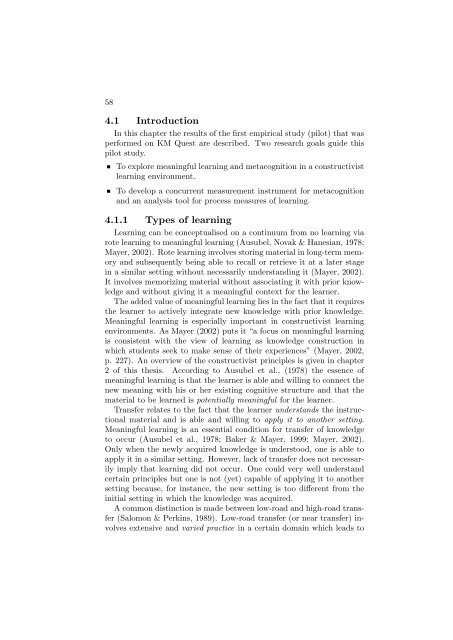The role of metacognitive skills in learning to solve problems
The role of metacognitive skills in learning to solve problems
The role of metacognitive skills in learning to solve problems
Create successful ePaper yourself
Turn your PDF publications into a flip-book with our unique Google optimized e-Paper software.
58<br />
4.1 Introduction<br />
In this chapter the results <strong>of</strong> the first empirical study (pilot) that was<br />
performed on KM Quest are described. Two research goals guide this<br />
pilot study.<br />
To explore mean<strong>in</strong>gful learn<strong>in</strong>g and metacognition <strong>in</strong> a constructivist<br />
learn<strong>in</strong>g environment.<br />
To develop a concurrent measurement <strong>in</strong>strument for metacognition<br />
and an analysis <strong>to</strong>ol for process measures <strong>of</strong> learn<strong>in</strong>g.<br />
4.1.1 Types <strong>of</strong> learn<strong>in</strong>g<br />
Learn<strong>in</strong>g can be conceptualised on a cont<strong>in</strong>uum from no learn<strong>in</strong>g via<br />
rote learn<strong>in</strong>g <strong>to</strong> mean<strong>in</strong>gful learn<strong>in</strong>g (Ausubel, Novak & Hanesian, 1978;<br />
Mayer, 2002). Rote learn<strong>in</strong>g <strong>in</strong>volves s<strong>to</strong>r<strong>in</strong>g material <strong>in</strong> long-term memory<br />
and subsequently be<strong>in</strong>g able <strong>to</strong> recall or retrieve it at a later stage<br />
<strong>in</strong> a similar sett<strong>in</strong>g without necessarily understand<strong>in</strong>g it (Mayer, 2002).<br />
It <strong>in</strong>volves memoriz<strong>in</strong>g material without associat<strong>in</strong>g it with prior knowledge<br />
and without giv<strong>in</strong>g it a mean<strong>in</strong>gful context for the learner.<br />
<strong>The</strong> added value <strong>of</strong> mean<strong>in</strong>gful learn<strong>in</strong>g lies <strong>in</strong> the fact that it requires<br />
the learner <strong>to</strong> actively <strong>in</strong>tegrate new knowledge with prior knowledge.<br />
Mean<strong>in</strong>gful learn<strong>in</strong>g is especially important <strong>in</strong> constructivist learn<strong>in</strong>g<br />
environments. As Mayer (2002) puts it “a focus on mean<strong>in</strong>gful learn<strong>in</strong>g<br />
is consistent with the view <strong>of</strong> learn<strong>in</strong>g as knowledge construction <strong>in</strong><br />
which students seek <strong>to</strong> make sense <strong>of</strong> their experiences” (Mayer, 2002,<br />
p. 227). An overview <strong>of</strong> the constructivist pr<strong>in</strong>ciples is given <strong>in</strong> chapter<br />
2 <strong>of</strong> this thesis. Accord<strong>in</strong>g <strong>to</strong> Ausubel et al., (1978) the essence <strong>of</strong><br />
mean<strong>in</strong>gful learn<strong>in</strong>g is that the learner is able and will<strong>in</strong>g <strong>to</strong> connect the<br />
new mean<strong>in</strong>g with his or her exist<strong>in</strong>g cognitive structure and that the<br />
material <strong>to</strong> be learned is potentially mean<strong>in</strong>gful for the learner.<br />
Transfer relates <strong>to</strong> the fact that the learner understands the <strong>in</strong>structional<br />
material and is able and will<strong>in</strong>g <strong>to</strong> apply it <strong>to</strong> another sett<strong>in</strong>g.<br />
Mean<strong>in</strong>gful learn<strong>in</strong>g is an essential condition for transfer <strong>of</strong> knowledge<br />
<strong>to</strong> occur (Ausubel et al., 1978; Baker & Mayer, 1999; Mayer, 2002).<br />
Only when the newly acquired knowledge is unders<strong>to</strong>od, one is able <strong>to</strong><br />
apply it <strong>in</strong> a similar sett<strong>in</strong>g. However, lack <strong>of</strong> transfer does not necessarily<br />
imply that learn<strong>in</strong>g did not occur. One could very well understand<br />
certa<strong>in</strong> pr<strong>in</strong>ciples but one is not (yet) capable <strong>of</strong> apply<strong>in</strong>g it <strong>to</strong> another<br />
sett<strong>in</strong>g because, for <strong>in</strong>stance, the new sett<strong>in</strong>g is <strong>to</strong>o different from the<br />
<strong>in</strong>itial sett<strong>in</strong>g <strong>in</strong> which the knowledge was acquired.<br />
A common dist<strong>in</strong>ction is made between low-road and high-road transfer<br />
(Salomon & Perk<strong>in</strong>s, 1989). Low-road transfer (or near transfer) <strong>in</strong>volves<br />
extensive and varied practice <strong>in</strong> a certa<strong>in</strong> doma<strong>in</strong> which leads <strong>to</strong>
















